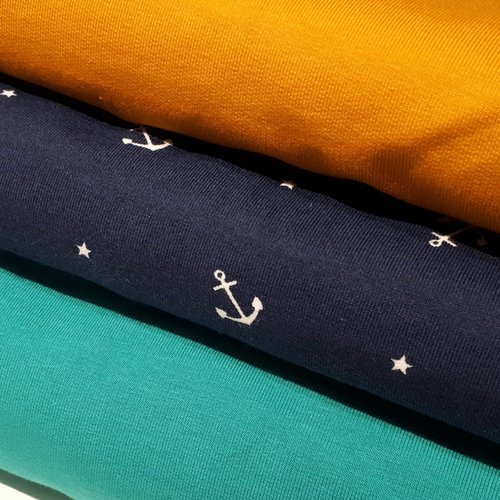Jersey Fabrics - all you need to know!
We often get asked about the different type of jersey fabrics, and how to choose the right fabric for the right patterns.
‘Jersey’ is a term used widely to define fabrics with a knitted construction, usually made using a knitting machine, as opposed to a woven fabric which is made on a loom.
The feel of a jersey fabric differs depending on the type of knit and the fibre content of the material.
Basic jersey is made in one of 2 knit structures:
Single jersey - this usually feels slightly thinner and has a V pattern on the front side. It can be very stretchy.
Double jersey - this usually looks the same on both sides and is often slightly thicker and more stable.
SINGLE JERSEY COMPOSITIONS AND TYPES:
Viscose jersey - often a viscose and elastane mix
Feel: Lightweight and drapey. Cold to the touch
Use: Tops, looser trousers and dresses with drape
Viscose jersey can roll at the edges and it is often very stretchy so not an ideal choice for absolute beginners. The elastane in the fabric stops the fabric stretching out too much and helps it retain it's shape
Polyester Jersey
Feel: Smooth and warm synthetic feel. Often very lightweight
Use: Close fitting garments
Often a cheaper choice, polyester jersey comes in a huge verity of colours and prints. It is a great choice for sports wear, but can be prone to pilling and static.
Pick a lightweight cotton elastane, polyester or viscose jersey in a fun print for an easy everyday Cosy Jersey Dress
Cotton Jersey
Feel: Crisp but soft and slightly brushed warmer feel - even lighter weight versions
Use: Loose fitting t-shirts, dresses, nightwear
Cotton is cool and breathable and very comfortable to wear in warm weather. However, 100% cotton knits can stretch out and become baggy, returning to their original dimensions less easily than those with added elastane (see next type)
Cotton and Elastane Mix Jersey - usually around 3% elastane
Feel: Soft and warm with slightly brushed feel. Often a bit thicker than other jerseys
Use: Close fitting tops, dresses, leggings, underwear
This mix can roll at the edges when cut, but it is less stretchy and more stable than jersey made from just viscose. Rolling can be counteracted with iron on interfacing tape or spray starch
True Knit Jersey
Feel: Like traditional knitting it has more prominent and large stitches and is heavier weight
Use: Cardigans, jumpers and jumper dresses
True knit fabric is best finished with an overlocker as it can ladder and fray easily. It also has a definite right and wrong side.
True knit fabric is a great choice for the The Funnel Neck Jumper
French Terry/ loopback Jersey
Feel: Depends on composition but usually cotton and elastane is medium weight with a slightly cooler feel, or if mixed with some polyester content this adds softness and warmth. Has a looped back side and a smooth, often printed front side. Usually medium weight.
Use: lightweight sweaters, cardis, leggings/close fit joggers, casual dresses
Sweater knit – various compositions
Feel: soft and warm, often spongy and stable with less stretch. Often they have a loopy (loop-back) or brushed/fleecy (brushed-back/fleece-backed) side and are heavyweight.
Use: Sweatshirts and hoodies, joggers
Cosy brushed back sweat fabrics are the perfect choice for the Homebody Hoodie
DOUBLE JERSEY COMPOSITIONS AND TYPES:
Ponti (Ponti di Roma)
Feel: stable with some stretch. Medium weight, good return to original dimensions. Usually a mix of polyester, viscose and elastane. Smooth with a slight shine.
Use: ideal for bottoms – Skirts, dresses, trousers, more formal garments
Ponti Roma is stable and perfect for beginners to work with. It has some body and structure to the fabric, meaning it doesn't drape a lot. Due to the polyester content, it can be prone to pilling.
Interlock jersey
Feel: thick and stable. Usually 100% cotton
Use: Baby and childrenswear, t-shirts, nightwear
100% cotton knits can stretch out and return to their original dimensions. Colours usually look more subdued and natural.
OTHER JERSEYS/KNITS:
Quilted jersey – usually 2-3 layers bonded together to create a quilted effect. Can be made from a combination of fiber contents.
Mixing textures and using the right and wrong side of fabrics in panelled styles like the cosy jersey jumper can create really interesting effects
Slub jersey – has the same properties as single cotton jersey but with a sluby, textured feel and look
Yarn dyed stripes – yarn is dyed then knitted together in a stripe pattern which shows on both sides of the fabric, can be a variety of competition and weights.
Printed stripes- plain fabric is printed with a stripe pattern usually on one side only. More common in heavy weight bases, and the printing ink can add a crispness and weight to the fabric.
Modal is a fibre which can be added to single jersey and gives a superior softness and warmth
Elastane, Lycra and spandex are the same thing – they are all an elastic fibre which add stretch and return to fabrics. High content can make fabrics shiny.
Sewing and wearing jersey can be really fun and rewarding. I hope this has helped clarify the jargon around jersey fabrics so you can choose the right fabric for your next projects.





